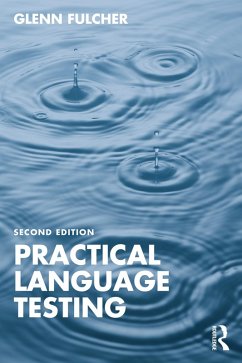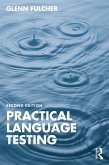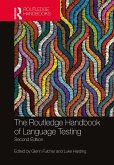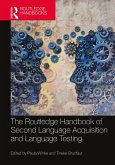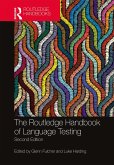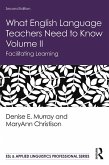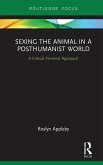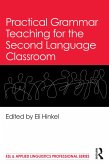Glenn Fulcher
Practical Language Testing (eBook, ePUB)
41,95 €
41,95 €
inkl. MwSt.
Sofort per Download lieferbar

21 °P sammeln
41,95 €
Als Download kaufen

41,95 €
inkl. MwSt.
Sofort per Download lieferbar

21 °P sammeln
Jetzt verschenken
Alle Infos zum eBook verschenken
41,95 €
inkl. MwSt.
Sofort per Download lieferbar
Alle Infos zum eBook verschenken

21 °P sammeln
Glenn Fulcher
Practical Language Testing (eBook, ePUB)
- Format: ePub
- Merkliste
- Auf die Merkliste
- Bewerten Bewerten
- Teilen
- Produkt teilen
- Produkterinnerung
- Produkterinnerung

Bitte loggen Sie sich zunächst in Ihr Kundenkonto ein oder registrieren Sie sich bei
bücher.de, um das eBook-Abo tolino select nutzen zu können.
Hier können Sie sich einloggen
Hier können Sie sich einloggen
Sie sind bereits eingeloggt. Klicken Sie auf 2. tolino select Abo, um fortzufahren.

Bitte loggen Sie sich zunächst in Ihr Kundenkonto ein oder registrieren Sie sich bei bücher.de, um das eBook-Abo tolino select nutzen zu können.
Practical Language Testing equips you with the skills, knowledge and principles necessary to understand and construct language tests. This practical guide offers step-by-step guidelines on the design of assessments within the classroom, and provides the necessary tools to analyse and improve assessments.
- Geräte: eReader
- mit Kopierschutz
- eBook Hilfe
Andere Kunden interessierten sich auch für
![Practical Language Testing (eBook, PDF) Practical Language Testing (eBook, PDF)]() Glenn FulcherPractical Language Testing (eBook, PDF)41,95 €
Glenn FulcherPractical Language Testing (eBook, PDF)41,95 €![The Routledge Handbook of Language Testing (eBook, ePUB) The Routledge Handbook of Language Testing (eBook, ePUB)]() The Routledge Handbook of Language Testing (eBook, ePUB)47,95 €
The Routledge Handbook of Language Testing (eBook, ePUB)47,95 €![The Routledge Handbook of Second Language Acquisition and Language Testing (eBook, ePUB) The Routledge Handbook of Second Language Acquisition and Language Testing (eBook, ePUB)]() The Routledge Handbook of Second Language Acquisition and Language Testing (eBook, ePUB)47,95 €
The Routledge Handbook of Second Language Acquisition and Language Testing (eBook, ePUB)47,95 €![The Routledge Handbook of Language Testing (eBook, PDF) The Routledge Handbook of Language Testing (eBook, PDF)]() The Routledge Handbook of Language Testing (eBook, PDF)47,95 €
The Routledge Handbook of Language Testing (eBook, PDF)47,95 €![What English Language Teachers Need to Know Volume II (eBook, ePUB) What English Language Teachers Need to Know Volume II (eBook, ePUB)]() Denise E. MurrayWhat English Language Teachers Need to Know Volume II (eBook, ePUB)45,95 €
Denise E. MurrayWhat English Language Teachers Need to Know Volume II (eBook, ePUB)45,95 €![Sexing the Animal in a Post-Humanist World (eBook, ePUB) Sexing the Animal in a Post-Humanist World (eBook, ePUB)]() Roslyn ApplebySexing the Animal in a Post-Humanist World (eBook, ePUB)23,95 €
Roslyn ApplebySexing the Animal in a Post-Humanist World (eBook, ePUB)23,95 €![Practical Grammar Teaching for the Second Language Classroom (eBook, ePUB) Practical Grammar Teaching for the Second Language Classroom (eBook, ePUB)]() Practical Grammar Teaching for the Second Language Classroom (eBook, ePUB)42,95 €
Practical Grammar Teaching for the Second Language Classroom (eBook, ePUB)42,95 €-
-
-
Practical Language Testing equips you with the skills, knowledge and principles necessary to understand and construct language tests. This practical guide offers step-by-step guidelines on the design of assessments within the classroom, and provides the necessary tools to analyse and improve assessments.
Dieser Download kann aus rechtlichen Gründen nur mit Rechnungsadresse in A, B, BG, CY, CZ, D, DK, EW, E, FIN, F, GR, HR, H, IRL, I, LT, L, LR, M, NL, PL, P, R, S, SLO, SK ausgeliefert werden.
Produktdetails
- Produktdetails
- Verlag: Taylor & Francis eBooks
- Erscheinungstermin: 29. November 2024
- Englisch
- ISBN-13: 9781040153338
- Artikelnr.: 72288126
- Verlag: Taylor & Francis eBooks
- Erscheinungstermin: 29. November 2024
- Englisch
- ISBN-13: 9781040153338
- Artikelnr.: 72288126
- Herstellerkennzeichnung Die Herstellerinformationen sind derzeit nicht verfügbar.
Glenn Fulcher is Emeritus Professor of Education and Language Assessment in the School of Education at the University of Leicester, UK. He is co-editor of The Routledge Handbook of Language Testing and author of Re-examining Language Testing: A Philosophical and Social Inquiry. These two books jointly won the SAGE/ILTA Book Award in 2016. His other books include Language Testing and Assessment: An Advanced Resource Book and Testing Second Language Speaking. He has published over 100 research papers. In 2021 he received the Messick Memorial Award from Educational Testing Service, and in 2022 was elected a fellow of the Academy of Social Sciences. He is also a UK National Teaching Fellow.
Acknowledgements
Preface
Chapter 1 - Testing and assessment in context
1. Test purpose
2. Tests in educational systems
3. Testing rituals
4. Unintended consequences
5. Testing and society
6. Historical interlude I
7. The politics of language testing
8. Historical interlude II
9. Professionalising language education and testing
10. Validity
Activities
Chapter 2 - Standardised testing
1. Two paradigms
2. Testing as science
3. What's in a curve?
4. The curve and score meaning
5. Putting it into practice
6. Test scores in a consumer age
7. Testing the test
8. Introducing reliability
9. Calculating reliability
10. Living with uncertainty
11. Reliability and test length
12. Relationships with other measures
13. Measurement
Activities
Chapter 3 - Classroom assessment
1. Life at the chalk-face
2. Assessment for learning
3. Self- and peer-assessment
4. Dynamic assessment
5. Understanding change
6. Assessment and second language acquisition
7. Criterion-referenced testing
8. Dependability
9. Assessment literacy
Activities
Chapter 4 - Deciding what to test
1. The test design cycle
2. Construct definition
3. Where do constructs come from?
4. Models of communicative competence
5. From definition to design
Activities
Chapter 5 - Designing test specifications
1. What are test specifications?
2. Specifications for testing and teaching
3. A sample detailed specification for reading test
4. Granularity
5. Performance conditions
6. Target language use domain analysis
7. Accommodations
8. Back and forth
Activities
Chapter 6 - Evaluating, prototyping and piloting
1. Investigating usefulness and usability
2. Evaluating items, tasks and specifications
3. Guidelines for multiple-choice items
4. Prototyping
5. Piloting
6. Field testing
7. Item shells
8. Operational item review and pre-testing
Activities
Chapter 7 - Scoring language tests
1. Scoring items
2. Scorability
3. Scoring constructed response tasks
4. Automated scoring
5. Corrections for guessing
6. Avoiding own goals
Activities
Chapter 8 - Aligning tests to standards
1. It's as old as the hills
2. The definition of 'standards'
3. The uses of standards
4. Unintended consequences revisited
5. Using standards for harmonisation and identity
6. How many standards can we afford?
7. Performance level descriptors (PLDs) and test scores
8. Some initial decisions
9. Standards-setting methodologies
10. Evaluating standard-setting
11. Training
12. The special case of CEFR
13. You can always count on uncertainty
Activities
Chapter 9 - Validity
1. Preliminaries
2. The Messick consensus
3. Argument-based validation
4. Technicalism
5. The new realism
6. Constructivism
7. Pragmatic realism
8. Conclusion
Activities
Epilogue
Appendices
Glossary
References
Index
Preface
Chapter 1 - Testing and assessment in context
1. Test purpose
2. Tests in educational systems
3. Testing rituals
4. Unintended consequences
5. Testing and society
6. Historical interlude I
7. The politics of language testing
8. Historical interlude II
9. Professionalising language education and testing
10. Validity
Activities
Chapter 2 - Standardised testing
1. Two paradigms
2. Testing as science
3. What's in a curve?
4. The curve and score meaning
5. Putting it into practice
6. Test scores in a consumer age
7. Testing the test
8. Introducing reliability
9. Calculating reliability
10. Living with uncertainty
11. Reliability and test length
12. Relationships with other measures
13. Measurement
Activities
Chapter 3 - Classroom assessment
1. Life at the chalk-face
2. Assessment for learning
3. Self- and peer-assessment
4. Dynamic assessment
5. Understanding change
6. Assessment and second language acquisition
7. Criterion-referenced testing
8. Dependability
9. Assessment literacy
Activities
Chapter 4 - Deciding what to test
1. The test design cycle
2. Construct definition
3. Where do constructs come from?
4. Models of communicative competence
5. From definition to design
Activities
Chapter 5 - Designing test specifications
1. What are test specifications?
2. Specifications for testing and teaching
3. A sample detailed specification for reading test
4. Granularity
5. Performance conditions
6. Target language use domain analysis
7. Accommodations
8. Back and forth
Activities
Chapter 6 - Evaluating, prototyping and piloting
1. Investigating usefulness and usability
2. Evaluating items, tasks and specifications
3. Guidelines for multiple-choice items
4. Prototyping
5. Piloting
6. Field testing
7. Item shells
8. Operational item review and pre-testing
Activities
Chapter 7 - Scoring language tests
1. Scoring items
2. Scorability
3. Scoring constructed response tasks
4. Automated scoring
5. Corrections for guessing
6. Avoiding own goals
Activities
Chapter 8 - Aligning tests to standards
1. It's as old as the hills
2. The definition of 'standards'
3. The uses of standards
4. Unintended consequences revisited
5. Using standards for harmonisation and identity
6. How many standards can we afford?
7. Performance level descriptors (PLDs) and test scores
8. Some initial decisions
9. Standards-setting methodologies
10. Evaluating standard-setting
11. Training
12. The special case of CEFR
13. You can always count on uncertainty
Activities
Chapter 9 - Validity
1. Preliminaries
2. The Messick consensus
3. Argument-based validation
4. Technicalism
5. The new realism
6. Constructivism
7. Pragmatic realism
8. Conclusion
Activities
Epilogue
Appendices
Glossary
References
Index
Acknowledgements
Preface
Chapter 1 - Testing and assessment in context
1. Test purpose
2. Tests in educational systems
3. Testing rituals
4. Unintended consequences
5. Testing and society
6. Historical interlude I
7. The politics of language testing
8. Historical interlude II
9. Professionalising language education and testing
10. Validity
Activities
Chapter 2 - Standardised testing
1. Two paradigms
2. Testing as science
3. What's in a curve?
4. The curve and score meaning
5. Putting it into practice
6. Test scores in a consumer age
7. Testing the test
8. Introducing reliability
9. Calculating reliability
10. Living with uncertainty
11. Reliability and test length
12. Relationships with other measures
13. Measurement
Activities
Chapter 3 - Classroom assessment
1. Life at the chalk-face
2. Assessment for learning
3. Self- and peer-assessment
4. Dynamic assessment
5. Understanding change
6. Assessment and second language acquisition
7. Criterion-referenced testing
8. Dependability
9. Assessment literacy
Activities
Chapter 4 - Deciding what to test
1. The test design cycle
2. Construct definition
3. Where do constructs come from?
4. Models of communicative competence
5. From definition to design
Activities
Chapter 5 - Designing test specifications
1. What are test specifications?
2. Specifications for testing and teaching
3. A sample detailed specification for reading test
4. Granularity
5. Performance conditions
6. Target language use domain analysis
7. Accommodations
8. Back and forth
Activities
Chapter 6 - Evaluating, prototyping and piloting
1. Investigating usefulness and usability
2. Evaluating items, tasks and specifications
3. Guidelines for multiple-choice items
4. Prototyping
5. Piloting
6. Field testing
7. Item shells
8. Operational item review and pre-testing
Activities
Chapter 7 - Scoring language tests
1. Scoring items
2. Scorability
3. Scoring constructed response tasks
4. Automated scoring
5. Corrections for guessing
6. Avoiding own goals
Activities
Chapter 8 - Aligning tests to standards
1. It's as old as the hills
2. The definition of 'standards'
3. The uses of standards
4. Unintended consequences revisited
5. Using standards for harmonisation and identity
6. How many standards can we afford?
7. Performance level descriptors (PLDs) and test scores
8. Some initial decisions
9. Standards-setting methodologies
10. Evaluating standard-setting
11. Training
12. The special case of CEFR
13. You can always count on uncertainty
Activities
Chapter 9 - Validity
1. Preliminaries
2. The Messick consensus
3. Argument-based validation
4. Technicalism
5. The new realism
6. Constructivism
7. Pragmatic realism
8. Conclusion
Activities
Epilogue
Appendices
Glossary
References
Index
Preface
Chapter 1 - Testing and assessment in context
1. Test purpose
2. Tests in educational systems
3. Testing rituals
4. Unintended consequences
5. Testing and society
6. Historical interlude I
7. The politics of language testing
8. Historical interlude II
9. Professionalising language education and testing
10. Validity
Activities
Chapter 2 - Standardised testing
1. Two paradigms
2. Testing as science
3. What's in a curve?
4. The curve and score meaning
5. Putting it into practice
6. Test scores in a consumer age
7. Testing the test
8. Introducing reliability
9. Calculating reliability
10. Living with uncertainty
11. Reliability and test length
12. Relationships with other measures
13. Measurement
Activities
Chapter 3 - Classroom assessment
1. Life at the chalk-face
2. Assessment for learning
3. Self- and peer-assessment
4. Dynamic assessment
5. Understanding change
6. Assessment and second language acquisition
7. Criterion-referenced testing
8. Dependability
9. Assessment literacy
Activities
Chapter 4 - Deciding what to test
1. The test design cycle
2. Construct definition
3. Where do constructs come from?
4. Models of communicative competence
5. From definition to design
Activities
Chapter 5 - Designing test specifications
1. What are test specifications?
2. Specifications for testing and teaching
3. A sample detailed specification for reading test
4. Granularity
5. Performance conditions
6. Target language use domain analysis
7. Accommodations
8. Back and forth
Activities
Chapter 6 - Evaluating, prototyping and piloting
1. Investigating usefulness and usability
2. Evaluating items, tasks and specifications
3. Guidelines for multiple-choice items
4. Prototyping
5. Piloting
6. Field testing
7. Item shells
8. Operational item review and pre-testing
Activities
Chapter 7 - Scoring language tests
1. Scoring items
2. Scorability
3. Scoring constructed response tasks
4. Automated scoring
5. Corrections for guessing
6. Avoiding own goals
Activities
Chapter 8 - Aligning tests to standards
1. It's as old as the hills
2. The definition of 'standards'
3. The uses of standards
4. Unintended consequences revisited
5. Using standards for harmonisation and identity
6. How many standards can we afford?
7. Performance level descriptors (PLDs) and test scores
8. Some initial decisions
9. Standards-setting methodologies
10. Evaluating standard-setting
11. Training
12. The special case of CEFR
13. You can always count on uncertainty
Activities
Chapter 9 - Validity
1. Preliminaries
2. The Messick consensus
3. Argument-based validation
4. Technicalism
5. The new realism
6. Constructivism
7. Pragmatic realism
8. Conclusion
Activities
Epilogue
Appendices
Glossary
References
Index
